The Nightmare Before Christmas
8.6 /10 3 Votes
94% Rotten Tomatoes Duration Language English | 8/10 IMDb 4.6/5 Amazon Genre Animation, Family, Fantasy Country United States | |||||||||||||||||||||||||||||||||
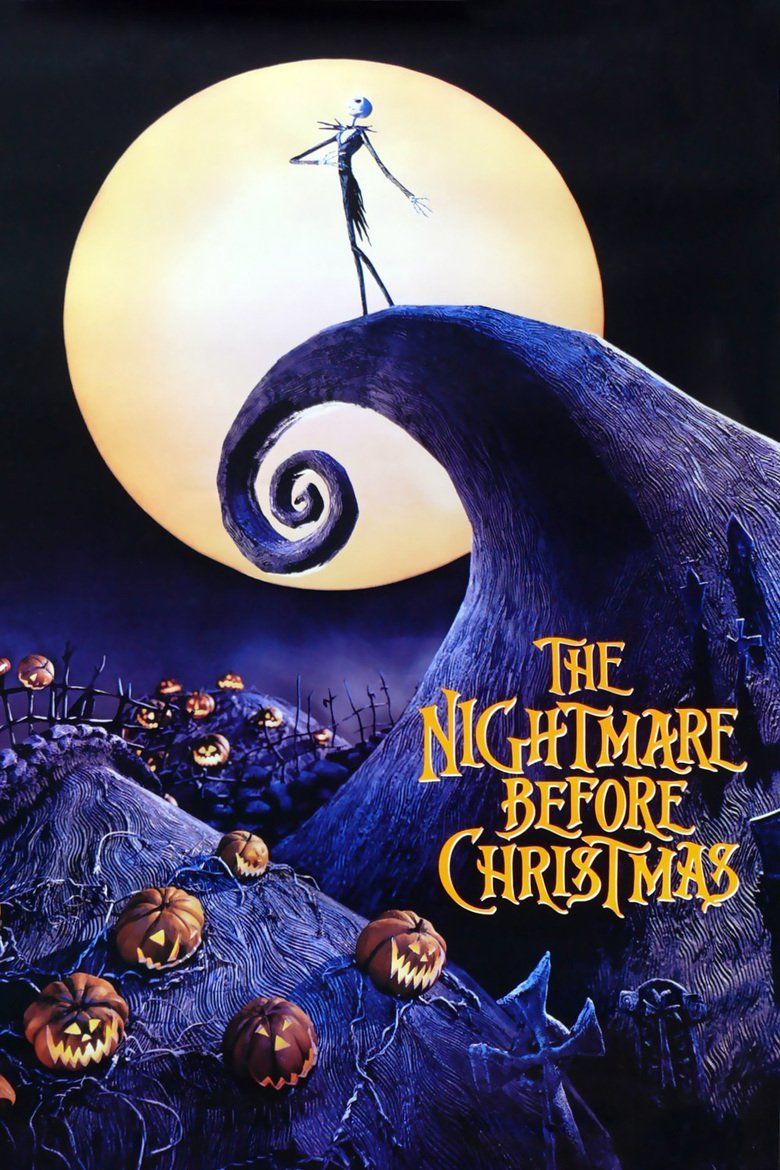 | ||||||||||||||||||||||||||||||||||
Release date October 29, 1993 (1993-10-29) Writer Tim Burton (based on: a story and characters by), Michael McDowell (adaptation), Caroline Thompson (screenplay) Cast (Jack Skellington (singing) / Barrel / Clown with the Tear away Face (voice)), (Jack Skellington (voice)), (Sally / Shock (voice)), (Dr. Finkelstein (voice)), (Mayor (voice)), (Lock (voice)) Songs Nightmare Before Christmas: Overture Characters Jack Skellington (Danny Elfman), Sally (Catherine OHara), Santa Claus (Edward Ivory), The Devil (Greg Proops), Dr Finkelstein (William Hickey) Similar movies Hotel Transylvania 2 , Cinderella , Frozen , Pirates of the Caribbean: The Curse of the Black Pearl , , Hotel Transylvania Tagline A ghoulish tale with wicked humour & stunning animation. | ||||||||||||||||||||||||||||||||||
The nightmare before christmas 1993 official trailer 1 animated movie
The Nightmare Before Christmas (also known as Tim Burton's The Nightmare Before Christmas) is a 1993 American stop-motion animated musical dark fantasy film directed by Henry Selick, and produced and conceived by Tim Burton. It tells the story of Jack Skellington, a resident from "Halloween Town" who stumbles through a portal to "Christmas Town" and decides to celebrate the holiday, with some dastardly and comical consequences. Danny Elfman wrote the songs and score, and provided the singing voice of Jack. The principal voice cast also includes Chris Sarandon, Catherine O'Hara, William Hickey, Ken Page, Paul Reubens and Glenn Shadix.
Contents
- The nightmare before christmas 1993 official trailer 1 animated movie
- The nightmare before christmas theatrical trailer
- Plot
- Voice Cast
- Development
- Filming
- Soundtracks
- Release
- Home media
- Marketing
- Box office
- Critical response
- Accolades
- Possible sequel
- Related media
- References

The Nightmare Before Christmas originated in a poem written by Tim Burton in 1982, while he was working as an animator at Walt Disney Feature Animation. With the success of Vincent in the same year, Walt Disney Studios began to consider developing The Nightmare Before Christmas as either a short film or 30-minute television special. Over the years, Burton's thoughts regularly returned to the project, and in 1990, he made a development deal with Disney. Production started in July 1991 in San Francisco; Disney released the film through its Touchstone Pictures banner because the studio believed the film would be "too dark and scary for kids".
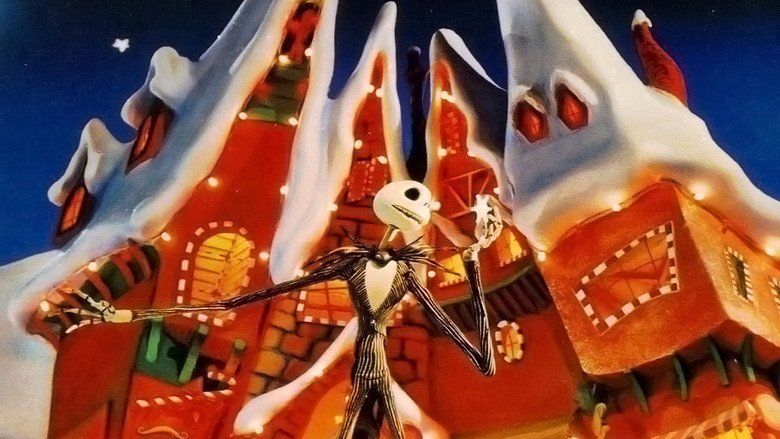
The film was met with both critical and financial success, grossing over $76 million during its initial run. It was nominated for the Academy Award for Best Visual Effects, a first for an animated film. The film has since been reissued by Walt Disney Pictures, and was re-released annually in Disney Digital 3-D from 2006 until 2009, making it the first stop-motion animated feature to be entirely converted to 3D.
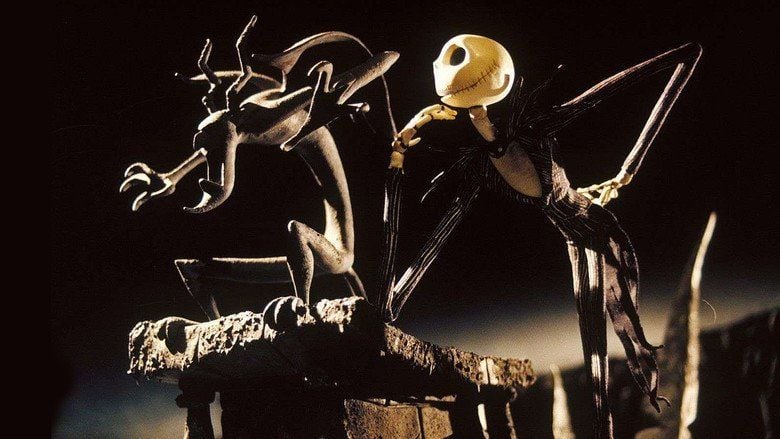
The nightmare before christmas theatrical trailer
Plot

Halloween Town is a fantasy world filled with citizens such as deformed monsters, ghosts, ghouls, goblins, zombies, mummies, vampires, werewolves and witches. Jack Skellington, the "Pumpkin King" and leader of the town, leads them in organizing the annual Halloween celebrations. However, privately Jack has grown weary of the same routine year after year, and wants something new. Wandering in the woods the morning after Halloween, he stumbles across seven trees containing doors leading to towns representing various holidays, and opens a portal to Christmas Town. Awed by the unfamiliar holiday, Jack returns to Halloween Town to show the residents his findings, but they fail to grasp the idea of Christmas and compare everything to their ideas of Halloween. Jack sequesters himself in his tower to study Christmas and find a way to rationally explain it, but cannot. He ultimately decides that it's unfair for Christmas Town alone to enjoy the holiday and announces that he and the citizens of Halloween Town will take over Christmas this year.

Jack assigns the citizens of Halloween Town Christmas-themed jobs, including singing carols, making presents, and building a sleigh to be pulled by skeletal reindeer. Sally, a beautiful rag doll woman that is secretly in love with Jack, feels that their efforts will end in disaster, but Jack dismisses her and assigns her the task of sewing him a red coat to wear. He also tasks Lock, Shock and Barrel, a trio of mischievous trick-or-treating children, to abduct Santa Claus and bring him back to Halloween Town. Jack tells Santa he will be bringing Christmas to the world in his place this year. Jack orders the trio to keep Santa safe, but the trio instead deliver Santa to Oogie Boogie, a gambling-addict bogeyman, who plots to play a game with Santa's life at stake. Sally attempts to rescue Santa so he can stop Jack, but Oogie captures her as well.
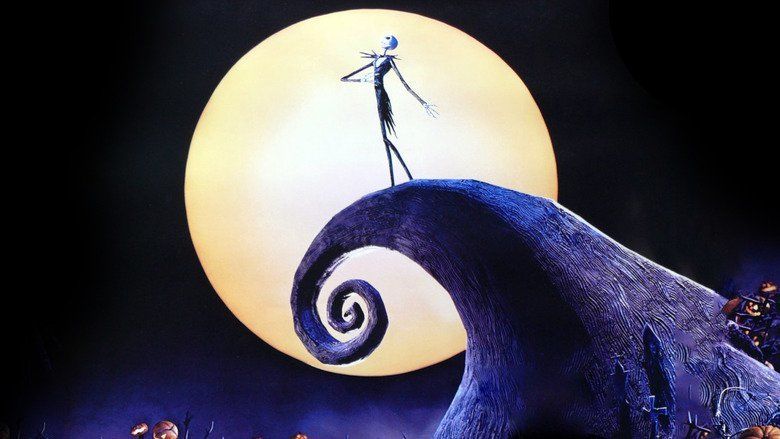
Jack departs to deliver presents to the world, but the Halloween-styled gifts terrify and attack the populace. As concerns over "Santa's" behavior grows, the military takes action and shoot down Jack, causing him to crash in the cemetery. As Jack bemoans the disaster he has made of Christmas, he finds he enjoyed the experience nonetheless, reigniting his love of Halloween. Jack returns to Halloween Town and finds Oogie's lair. Oogie tries to kill Jack, and Jack pulls apart the thread holding Oogie's cloth form together, revealing a massive pile of bugs that fall into Oogie's cauldron and are killed. Jack apologizes to Santa for his actions, and Santa assures Jack that he can fix things and returns to Christmas Town. As Santa replaces the Halloween-style presents with genuine ones, the townspeople of Halloween Town celebrate Jack's return. Santa then visits Halloween Town and brings them a snowfall for the residents to play with. In the graveyard, Jack and Sally declare their love for each other.
Voice Cast
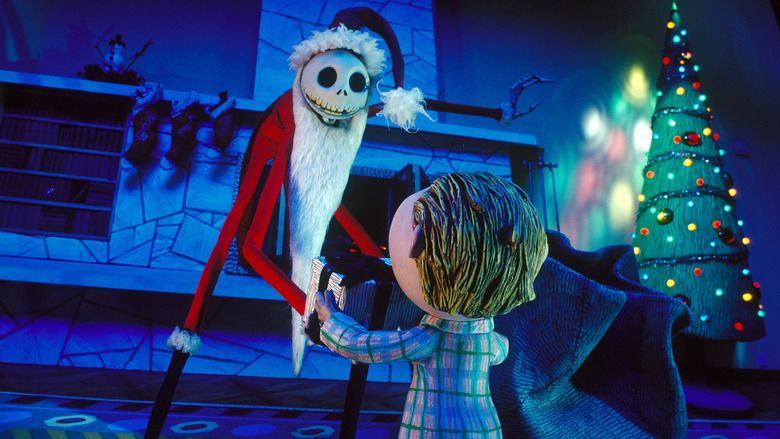

The cast also features Kerry Katz, Carmen Twillie, Randy Crenshaw, Debi Durst, Glenn Walters, Sherwood Ball, and Greg Proops voicing various characters. Patrick Stewart recorded narration for a prologue and epilogue. While not used in the final film, the narration is included on the soundtrack album.
Development
As writer Tim Burton's upbringing in Burbank, California was associated with the feeling of solitude, the filmmaker was largely fascinated by holidays during his childhood. "Anytime there was Christmas or Halloween, [...] it was great. It gave you some sort of texture all of a sudden that wasn't there before", Burton would later recall. After completing his short film Vincent in 1982, Burton, who was then-employed at Walt Disney Feature Animation, wrote a three-page poem titled The Nightmare Before Christmas, drawing inspiration from television specials of Rudolph the Red-Nosed Reindeer, How the Grinch Stole Christmas! and the poem A Visit from St. Nicholas. Burton intended to adapt the poem into a television special with the narration spoken by his favorite actor, Vincent Price, but also considered other options such as a children's book. He created concept art and storyboards for the project in collaboration with Rick Heinrichs, who also sculpted character models; Burton later showed his and Heinrichs' works-in-progress to Henry Selick, also a Disney animator at the time. After the success of Vincent in 1982, Disney started to consider developing The Nightmare Before Christmas as either a short film or 30-minute holiday television special. However, the project's development eventually stalled, as its tone seemed "too weird" to the company. As Disney was unable to "offer his nocturnal loners enough scope", Burton was fired from the studio in 1984, and went on to direct the commercially successful films Beetlejuice and Batman.
Over the years, Burton regularly thought about the project. In 1990, Burton found out that Disney still owned the film rights. He and Selick committed to produce a full-length film with the latter as director. Disney was looking forward to Nightmare "to show capabilities of technical and storytelling achievements that were present in Who Framed Roger Rabbit." Nightmare marked Burton's third film in a row to have a Christmas setting. Burton could not direct because of his commitment to Batman Returns and he did not want to be involved with "the painstakingly slow process of stop motion". To adapt his poem into a screenplay, Burton approached Michael McDowell, his collaborator on Beetlejuice. McDowell and Burton experienced creative differences, which convinced Burton to make the film as a musical with lyrics and compositions by frequent collaborator Danny Elfman. Elfman and Burton created a rough storyline and two-thirds of the film's songs. Elfman found writing Nightmare's eleven songs as "one of the easiest jobs I've ever had. I had a lot in common with Jack Skellington." Caroline Thompson still had yet to be hired to write the screenplay. With Thompson's screenplay, Selick stated, "there are very few lines of dialogue that are Caroline's. She became busy on other films and we were constantly rewriting, re-configuring and developing the film visually."
Filming
Selick and his team of animators began production in July 1991 in San Francisco, California with a crew of over 120 workers, utilizing 20 sound stages for filming. Joe Ranft was hired from Disney as a storyboard supervisor, while Eric Leighton was hired to supervise animation. At the peak of production, 20 individual stages were simultaneously being used for filming. In total, there were 109,440 frames taken for the film. The work of Ray Harryhausen, Ladislas Starevich, Edward Gorey, Charles Addams, Jan Lenica, Francis Bacon and Wassily Kandinsky influenced the filmmakers. Selick described the production design as akin to a pop-up book. In addition, Selick stated, "When we reach Halloween Town, it's entirely German Expressionism. When Jack enters Christmas Town, it's an outrageous Dr. Seuss-esque setpiece. Finally, when Jack is delivering presents in the 'Real World', everything is plain, simple and perfectly aligned." Vincent Price, Don Ameche, and James Earl Jones were considered to provide the narration for the film's prologue; however, all proved difficult to cast, and the producers instead hired local voice artist, Ed Ivory.
On the direction of the film, Selick reflected, "It's as though he [Burton] laid the egg, and I sat on it and hatched it. He wasn't involved in a hands-on way, but his hand is in it. It was my job to make it look like 'a Tim Burton film', which is not so different from my own films." When asked on Burton's involvement, Selick claimed, "I don't want to take away from Tim, but he was not in San Francisco when we made it. He came up five times over two years, and spent no more than eight or ten days in total." Walt Disney Feature Animation contributed with some use of second-layering traditional animation. Burton found production somewhat difficult because he was directing Batman Returns and in pre-production of Ed Wood.
The filmmakers constructed 227 puppets to represent the characters in the movie, with Jack Skellington having "around four hundred heads", allowing the expression of every possible emotion. Sally's mouth movements "were animated through the replacement method. During the animation process, [...] only Sally's face 'mask' was removed in order to preserve the order of her long, red hair. Sally had ten types of faces, each made with a series of eleven expressions (e.g. eyes open and closed, and various facial poses) and synchronized mouth movements." The stop motion figurine of Jack was reused in James and the Giant Peach (also directed by Selick) as Captain Jack.
Soundtracks
The film's soundtrack album was released in 1993 on Walt Disney Records. For the film's 2006 re-release in Disney Digital 3-D, a special edition of the soundtrack was released, featuring a bonus disc which contained covers of five of the film's songs by Fall Out Boy, Panic! at the Disco, Marilyn Manson, Fiona Apple, and She Wants Revenge. Four original demo tracks by Elfman were also included. On September 30, 2008, Disney released the cover album Nightmare Revisited, featuring artists such as Amy Lee, Flyleaf, Korn, Rise Against, Plain White T's, The All-American Rejects, and many more.
American gothic rock band London After Midnight featured a cover of "Sally's Song" on their 1998 album Oddities.
LiLi Roquelin did a French cover of "Sally's Song" which was released on her album Will you hate the rest of the world or will you renew your life? in 2010.
Another soundtrack released in 2003 was the Disneyland Haunted Mansion Holiday CD. Although most were not original songs from the movie, one song provided on the CD is a medley of "Making Christmas", "What's This?", and "Kidnap the Sandy Claws". Other songs included are original holiday songs changed to incorporate the theme of the movie. The last song on the list, however, is the soundtrack for the Disneyland Haunted Mansion Holiday ride.
Release
Disney decided to release the film under their Touchstone Pictures banner because they thought the film would be "too dark and scary for kids", Selick remembered. "Their biggest fear, and why it was kind of a stepchild project, [was] they were afraid of their core audience hating the film and not coming." To convey Burton's' involvement and attract a wider audience, Disney marketed the film as Tim Burton's The Nightmare Before Christmas. Burton explained that,"...it turned more into more of a brand-name thing, it turned into something else, which I'm not quite sure about." The film premiered at the New York Film Festival on October 9, and was given a limited release on October 15, 1993, before its wide theatrical release on October 29.
The Nightmare Before Christmas was reissued by Disney under the Walt Disney Pictures banner and re-released on October 20, 2006, with conversion to Disney Digital 3-D. Industrial Light & Magic assisted in the process. The film subsequently received annually releases in October 2007 and 2008. The El Capitan Theatre in Hollywood, California has been showing the film in 4-D screenings annually in October, ending on Halloween, since 2010. The reissues have led to a reemergence of 3-D films and advances in RealD Cinema.
Home media
With years of successful home video sales, Nightmare subsequently achieved the ranks of a cult film. Touchstone Home Video first released the film on VHS on September 30, 1994, and on DVD on December 2, 1997. The DVD release contained no special features. Nightmare was released a second time on October 3, 2000 as a special edition. The release included an audio commentary by Selick and cinematographer Pete Kozachik, a 28-minute making-of documentary, a gallery of concept art, storyboards, test footage and deleted scenes. Burton's Vincent and Frankenweenie were also included. Both DVDs were non-anamorphic widescreen releases.
Walt Disney Studios Home Entertainment released the film on DVD again (this time with an anamorphic transfer) and on Blu-ray Disc (for the first time) on August 26, 2008 as a two-disc digitally remastered "collector's edition", but still containing the same special features.
Walt Disney Studios Home Entertainment released The Nightmare Before Christmas on Blu-ray 3D on August 30, 2011. The release included a Blu-ray 3D disc, Blu-ray Disc and a DVD that includes both a DVD and digital copy of the film.
Marketing
Disney has undertaken an extensive marketing campaign of these characters across many media. Since 2001, Disneyland has held a seasonal Nightmare Before Christmas theme for its Haunted Mansion Holiday attraction. The attraction, an overlay of the park's Haunted Mansion, features characters, decorations and music from the film. In addition to Mickey's Not-So-Scary Halloween Party and Mickey's Halloween Party featuring the film's characters, Jack Skellington, Sally, Pajama Jack, and the Mayor have been made into Bendies figures, while Jack and Sally even appear in fine art. Moreover, Sally has been made into an action figure and a Halloween costume. A Jack Skellington figurine is available for the Disney Infinity video game, allowing the character to be playable in the game's "Toy Box Mode". Jack is also the titular character in the short story "Tim Burton's The Nightmare Before Christmas: Jack's Story". Nightmare has inspired video game spin-offs, including Oogie's Revenge and The Pumpkin King, and is among the many Disney-owned franchises that contribute to the mythology of the Kingdom Hearts series. A trading card game is also available.
Jim Edwards contends that "Tim Burton's animated movie The Nightmare Before Christmas is really a movie about the marketing business. The movie's lead character, Jack Skellington, the chief marketing officer (CMO) for a successful company, decides that his success is boring and he wants the company to have a different business plan."
Box office
Around the release of the film, Disney executive David Hoberman was quoted, "I hope Nightmare goes out and makes a fortune. If it does, great. If it doesn't, that doesn't negate the validity of the process. The budget was less than any Disney blockbuster so it doesn't have to earn Aladdin-sized grosses to satisfy us." The film earned $50 million in the United States on its first theatrical run.
The Nightmare Before Christmas made a further $8.7 million in box office gross in its 2006 reissue. The 2007 and 2008 reissues earned $14.5 million and $1.1 million, respectively, increasing the film's total box office gross to $75 million.
Critical response
The film initially received positive reviews from critics; it has since gone on to receive widespread critical acclaim. On Rotten Tomatoes, the film holds a rating of 94%, based on 88 reviews, with an average rating of 8.2/10. The site's consensus reads, "The Nightmare Before Christmas is a stunningly original and visually delightful work of stop-motion animation." On Metacritic the film has a score of 77 out of 100, based on 16 critics, indicating "generally favorable reviews".
Roger Ebert gave a highly positive review for Nightmare. Ebert believed the film's visual effects were as revolutionary as Star Wars, taking into account that Nightmare was "filled with imagination that carries us into a new world".
Peter Travers of Rolling Stone called it a restoration of "originality and daring to the Halloween genre. This dazzling mix of fun and fright also explodes the notion that animation is kid stuff. ... It's 74 minutes of timeless movie magic." James Berardinelli stated "The Nightmare Before Christmas has something to offer just about everyone. For the kids, it's a fantasy celebrating two holidays. For the adults, it's an opportunity to experience some light entertainment while marveling at how adept Hollywood has become at these techniques. There are songs, laughs, and a little romance. In short, The Nightmare Before Christmas does what it intends to: entertain." Desson Thomson of The Washington Post enjoyed stylistic features in common with Oscar Wilde, German Expressionism, the Brothers Grimm and The Cabinet of Dr. Caligari.
Michael A. Morrison discusses the influence of Dr. Seuss' How the Grinch Stole Christmas! on the film, writing that Jack parallels the Grinch and Zero parallels Max, the Grinch's dog. Philip Nel writes that the film "challenges the wisdom of adults through its trickster characters", contrasting Jack as a "good trickster" with Oogie Boogie, whom he also compares with Dr. Seuss' Dr. Terwilliker as a bad trickster. Entertainment Weekly reports that fan reception of these characters borders on obsession, profiling Laurie and Myk Rudnick, a couple whose "degree of obsession with [the] film is so great that ... they named their son after the real-life person that a character in the film is based on." This enthusiasm for the characters has also been profiled as having spread beyond North America to Japan. Yvonne Tasker notes "the complex characterization seen in The Nightmare Before Christmas".
Danny Elfman was worried the characterization of Oogie Boogie would be considered racist by the National Association for the Advancement of Colored People (NAACP). Elfman's predictions came true; however, director Henry Selick stated the character was inspired by the Betty Boop cartoon The Old Man of the Mountain. "Cab Calloway would dance his inimitable jazz dance and sing 'Minnie the Moocher' or 'Old Man of the Mountain', and they would rotoscope him, trace him, turn him into a cartoon character, often transforming him into an animal, like a walrus," Selick continued. "I think those are some of the most inventive moments in cartoon history, in no way racist, even though he was sometimes a villain. We went with Ken Page, who is a black singer, and he had no problem with it".
Accolades
The film was nominated for both the Academy Award for Best Visual Effects and the Hugo Award for Best Dramatic Presentation. Nightmare won the Saturn Award for Best Fantasy Film, while Elfman won Best Music. Selick and the animators were also nominated for their work. Elfman was nominated for the Golden Globe Award for Best Original Score. Most recently, the film ranked #1 on Rotten Tomatoes' "Top 25 Best Christmas Movies" list.
The film is recognized by American Film Institute in these lists:
Possible sequel
In 2001, Disney began to consider producing a sequel, but rather than using stop motion, Disney wanted to use computer animation. Burton convinced Disney to drop the idea. "I was always very protective of Nightmare not to do sequels or things of that kind," Burton explained. "You know, 'Jack visits Thanksgiving world' or other kinds of things just because I felt the movie had a purity to it and the people that like it... Because it's a mass-market kind of thing, it was important to kind of keep that purity of it." The 2004 video game The Nightmare Before Christmas: Oogie's Revenge did continue the story of the film, with Capcom's crew of developers going after Burton for advice, and having the collaboration of the film's art director, Deane Taylor. In 2009, Selick said he would do a film sequel if he and Burton could create a good story for it.
Related media
A collectible card game based on the film called The Nightmare Before Christmas TCG was released in 2005 by NECA. The game was designed by Quixotic Games founder Andrew Parks and Kez Shlasnger. It consists of a Premiere set and 4 Starter Decks based on four characters, Jack Skellington, the Mayor, Oogie Boogie, and Doctor Finklestein. Each Starter Deck contains a rule book, a Pumpkin King card, a Pumpkin Points card, and a 48-card deck. The game has four card types: Characters, Locales, Creations, and Surprises. The Cards' rarities are separated into four categories: Common, Uncommon, Rare, Ultra Rare.
Quixotic Games also developed The Nightmare Before Christmas Party Game that was released in 2007 by NECA.
A collector's edition The Nightmare Before Christmas-themed Jenga game was issued with orange, purple and black blocks with Jack Skellington heads on them. The set comes in a coffin-shaped box instead of the normal rectangular box.
A 168-card Munchkin Tim Burton's The Nightmare Before Christmas-themed Munchkin was developed by USAopoly featuring the citizens of Halloween Town such as Jack Skellington, Oogie Boogie, Doctor Finklestein, and Lock, Shock and Barrel. The game comes with a custom die similar to the ones used by Oogie Boogie in the film.
References
The Nightmare Before Christmas WikipediaThe Nightmare Before Christmas IMDbThe Nightmare Before Christmas Rotten TomatoesThe Nightmare Before Christmas Amazon.comThe Nightmare Before Christmas themoviedb.org
